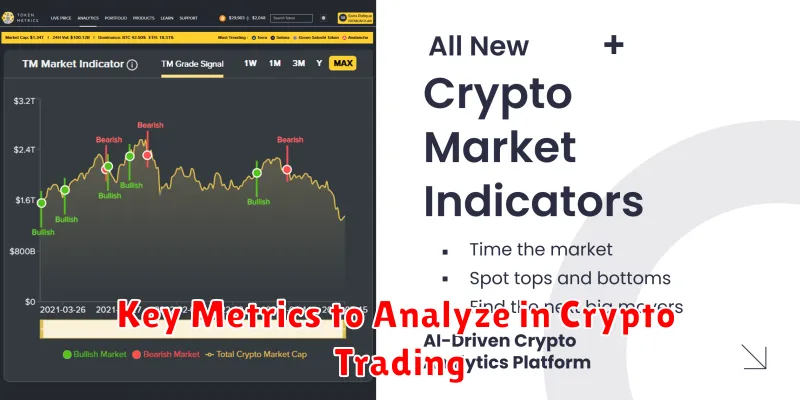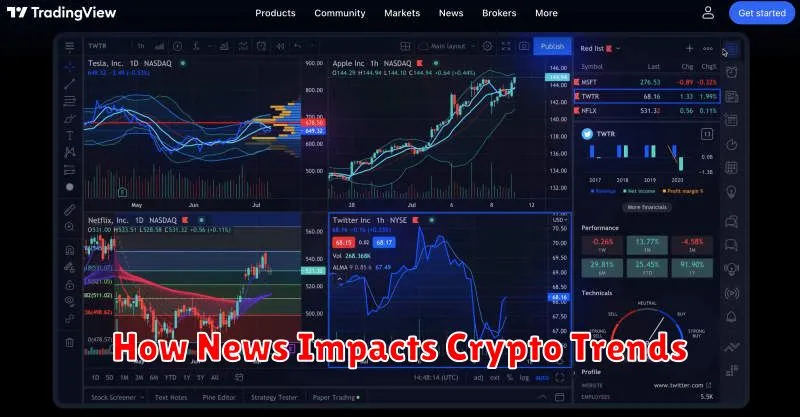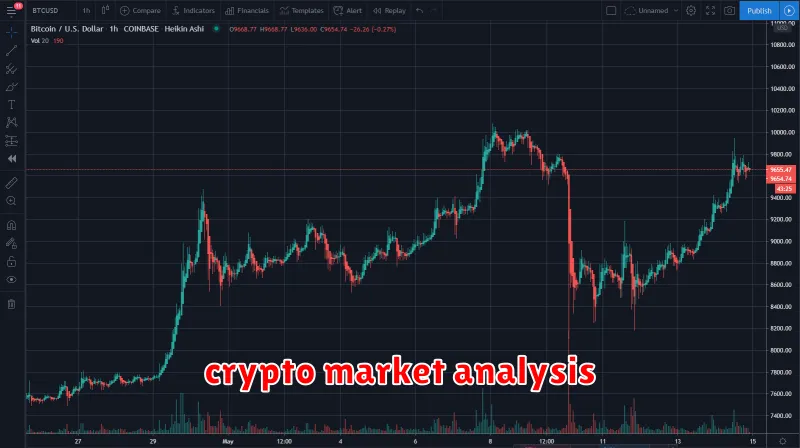Want to learn how to analyze crypto market trends like a seasoned pro? Unlock the secrets to successful crypto trading and master the art of market analysis. This comprehensive guide will equip you with the knowledge and skills to navigate the volatile world of cryptocurrency, helping you identify bullish and bearish trends, predict price movements, and make informed investment decisions. Discover the best strategies for cryptocurrency analysis, including technical indicators, fundamental analysis, and risk management techniques, to maximize your returns and minimize your losses. Let’s dive into the world of crypto market analysis and become experts together!
Understanding Market Cycles in Cryptocurrency
Cryptocurrency markets, like other asset classes, experience cyclical patterns. Understanding these cycles is crucial for successful trading and investment. These cycles aren’t perfectly predictable, but recognizing common phases can significantly improve your analysis.
A typical cycle often begins with an accumulation phase. This is characterized by low prices and relatively low trading volume. Smart money begins accumulating assets during this period.
Next comes the growth phase (often called a bull market). Prices start rising, fueled by increasing investor interest and positive news. This phase can be marked by rapid price increases and high trading volume.
The cycle peaks at a market top, characterized by extremely high prices and often fueled by hype and FOMO (fear of missing out). This is usually followed by a distribution phase where those who accumulated earlier start selling, creating downward pressure.
Finally, the market enters a bear market, defined by sustained price declines and negative sentiment. During this phase, prices can fall sharply, and trading volume might also decrease. This bearish trend often continues until a new accumulation phase begins, restarting the cycle.
It’s important to remember that these phases aren’t always clearly defined and can overlap. The duration of each phase can vary significantly, making it challenging to precisely time the market. However, understanding these general patterns enables you to better manage risk and identify potential opportunities. Focus on understanding the underlying fundamentals and technical indicators rather than trying to perfectly predict the market’s next move.
Key Metrics to Analyze in Crypto Trading

Successful crypto trading hinges on understanding and analyzing key market metrics. These metrics provide insights into market sentiment, price movements, and potential opportunities.
Price is the most obvious metric, but analyzing it requires more than just looking at the current value. Consider price action: identifying patterns like support and resistance levels, trendlines, and candlestick formations. These help predict future price movements.
Volume is crucial. High volume accompanying price increases suggests strong buying pressure, while high volume with falling prices indicates strong selling pressure. Low volume can signal indecision or a lack of conviction in the market.
Market Capitalization gives you a sense of a cryptocurrency’s overall size and influence. It’s the total value of all coins in circulation. Larger market caps usually indicate more established and less volatile assets, but this isn’t always the case.
Trading Volume indicates the liquidity of an asset. High trading volume implies easy buying and selling, while low volume can lead to significant price swings with smaller trades.
Moving Averages (MAs) like the simple moving average (SMA) and exponential moving average (EMA) smooth out price fluctuations and identify trends. They are helpful in identifying potential entry and exit points.
Relative Strength Index (RSI) and other oscillators help identify overbought and oversold conditions. These can signal potential price reversals. However, remember that these indicators can give false signals.
Dominance, specifically Bitcoin dominance, shows Bitcoin’s percentage of the total crypto market capitalization. A rising Bitcoin dominance might indicate a shift in investor sentiment towards safer assets.
By carefully analyzing these key metrics, alongside fundamental analysis of the underlying project, you can significantly improve your ability to predict market trends and make informed trading decisions. Remember that no single metric offers a foolproof prediction, and successful trading requires a holistic approach.
Using Technical Analysis for Better Decisions

Technical analysis is a crucial tool for navigating the volatile crypto market. It involves studying price charts and trading volume to identify patterns and predict future price movements. Unlike fundamental analysis, which focuses on a project’s underlying value, technical analysis is solely concerned with market action.
By understanding various technical indicators, you can gain valuable insights. Moving averages (like the 20-day and 50-day MA) smooth out price fluctuations, helping to identify trends. Relative Strength Index (RSI) measures momentum and can signal overbought or oversold conditions. Support and resistance levels pinpoint price areas where buying and selling pressure is strong.
Chart patterns, such as head and shoulders, double tops/bottoms, and triangles, can also predict potential price reversals or continuations. Learning to recognize these patterns improves your ability to anticipate market shifts. Remember, however, that technical analysis is not a foolproof method; it’s a probability game. Combining it with other forms of analysis, such as fundamental analysis, can greatly enhance your decision-making process.
Risk management is paramount. Employing strategies like stop-loss orders limits potential losses. No single indicator guarantees success; rather, the strength of your analysis lies in combining multiple indicators and patterns to confirm trading signals. The more you practice and refine your skills, the better your ability to make informed decisions in the dynamic cryptocurrency market.
The Role of Fundamental Analysis
Fundamental analysis in cryptocurrency, much like in traditional finance, focuses on evaluating the intrinsic value of a cryptocurrency or related project. Unlike technical analysis which examines price charts and trading volume, fundamental analysis delves into the underlying factors that influence a cryptocurrency’s long-term price.
Key elements of fundamental analysis include assessing the project’s technology, examining the team’s competence and reputation, analyzing the size and activity of the community, and understanding the tokenomics (supply and distribution of the cryptocurrency).
A strong whitepaper outlining a clear use case and technological innovation is a crucial starting point. Analyzing the adoption rate, transaction volume, and developer activity provides insights into the project’s viability and growth potential.
Furthermore, understanding the regulatory landscape and potential legal challenges facing a particular cryptocurrency is vital. Market capitalization, while a broad indicator, also helps assess the overall scale and potential of a project.
By combining fundamental analysis with technical analysis, investors can develop a more holistic and informed understanding of the cryptocurrency market, leading to better investment decisions and risk management.
Tracking Whale Movements in the Market
Understanding the actions of whales – individuals or entities holding significant cryptocurrency – is crucial for analyzing market trends. Their massive trades can significantly impact price movements, creating opportunities and risks for smaller investors.
Several tools can help track whale activity. On-chain analysis platforms provide insights into large transactions, revealing potential buying or selling pressure. Monitoring exchange inflows and outflows can indicate whales accumulating or distributing their holdings. Furthermore, observing activity on decentralized exchanges (DEXs) can offer a clearer picture, as these transactions are often more transparent than those on centralized exchanges.
Social sentiment analysis can also provide clues. While not a direct measure of whale activity, a sudden surge in positive or negative sentiment, coupled with significant on-chain movements, might suggest whale manipulation or a major shift in market direction. Remember, however, that correlating sentiment with whale actions requires careful interpretation and shouldn’t be taken as definitive proof.
While tracking whale movements can be beneficial, it’s important to avoid overreliance on this information. Market trends are complex and influenced by numerous factors. Using whale tracking as one component of a broader analytical strategy, alongside fundamental and technical analysis, will offer a more holistic and accurate view of the market.
How News Impacts Crypto Trends

The cryptocurrency market is incredibly volatile, and news plays a significant role in shaping its trends. Positive news, such as regulatory approvals, major partnerships, or technological breakthroughs, can lead to a surge in prices and trading volume. Conversely, negative news, like security breaches, regulatory crackdowns, or prominent figure controversies, can trigger sharp price drops and market uncertainty.
Specific types of news hold particular weight. Announcements from influential figures like Elon Musk can drastically impact prices, often causing immediate and sometimes irrational market reactions. Regulatory developments in major jurisdictions heavily influence investor confidence and compliance, causing significant shifts in market sentiment. Similarly, reports on market adoption, such as increasing institutional investments or widespread consumer use, can create positive momentum.
Analyzing news impact requires a critical approach. Consider the source’s credibility, the potential bias, and the broader market context. Don’t rely solely on headlines; read the full article to understand the nuance and implications. Furthermore, look beyond isolated events; consider how the news aligns with existing market trends and long-term predictions. A single news item may have a fleeting effect, while a series of events can create a sustained bullish or bearish trend.
Staying informed is crucial. Follow reputable news sources, utilize social media with caution, and monitor official announcements from cryptocurrency projects. Developing the ability to discern credible information from hype is paramount for effectively analyzing the market and mitigating risk.
Using AI Tools for Market Predictions
Analyzing crypto market trends effectively often involves leveraging the power of AI tools. These tools can process vast amounts of data – far more than any human analyst could manage – identifying patterns and making predictions that would be impossible otherwise. This includes analyzing historical price data, trading volume, social media sentiment, and even news articles to gauge overall market sentiment.
Several AI-powered platforms offer predictive analytics specifically for the crypto market. These platforms employ sophisticated algorithms, including machine learning and deep learning techniques, to forecast price movements, identify potential trading opportunities, and assess risk. Some tools even offer sentiment analysis, helping you understand the overall feeling towards specific cryptocurrencies or the market as a whole.
However, it’s crucial to remember that AI predictions are not guarantees. While AI tools can be incredibly helpful, they are only as good as the data they are trained on and the algorithms they utilize. No tool can perfectly predict the future of the volatile crypto market. Always use AI predictions in conjunction with your own research and risk management strategies. Consider them a valuable tool to inform your decisions, but not the sole basis for them.
Ultimately, successful crypto market analysis involves a blend of human expertise and AI assistance. Your understanding of fundamental and technical analysis, coupled with the insights provided by AI tools, will allow you to make more informed and potentially more profitable trading decisions.
Avoiding FOMO in Volatile Markets
The crypto market is notorious for its volatility. One of the biggest challenges for investors is managing the fear of missing out (FOMO). This intense emotional response can lead to impulsive decisions, often resulting in poor investment choices.
The key to avoiding FOMO is a well-defined strategy. Before investing, establish clear entry and exit points based on your risk tolerance and market analysis. Sticking to your plan, regardless of short-term price fluctuations, is crucial. Don’t chase quick gains; instead, focus on your long-term goals.
Diversification is another powerful tool against FOMO. Don’t put all your eggs in one basket. Spreading your investments across different cryptocurrencies reduces the impact of any single asset’s price drop. This prevents panic selling driven by FOMO when one investment underperforms.
Regularly review your portfolio but avoid constant monitoring. Daily price checks fuel anxiety and increase the susceptibility to FOMO. Set aside specific times for reviewing your investments and focus on the bigger picture: your long-term strategy and overall portfolio performance.
Finally, remember that market corrections are a normal part of investing. Don’t let temporary dips trigger FOMO-driven purchases. A disciplined approach, coupled with robust research and a long-term perspective, is the best defense against the emotional pitfalls of a volatile market.

